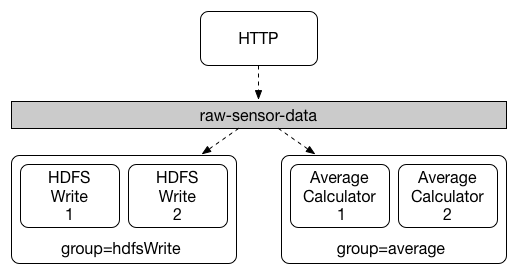Consumer Groups
While the publish-subscribe model makes it easy to connect applications through shared topics, the ability to scale up by creating multiple instances of a given application is equally important. When doing so, different instances of an application are placed in a competing consumer relationship, where only one of the instances is expected to handle a given message.
Spring Cloud Stream models this behavior through the concept of a consumer group.
(Spring Cloud Stream consumer groups are similar to and inspired by Kafka consumer groups.)
Each consumer binding can use the spring.cloud.stream.bindings.<bindingName>.group property to specify a group name.
For the consumers shown in the following figure, this property would be set as spring.cloud.stream.bindings.<bindingName>.group=hdfsWrite or spring.cloud.stream.bindings.<bindingName>.group=average.

All groups that subscribe to a given destination receive a copy of published data, but only one member of each group receives a given message from that destination. By default, when a group is not specified, Spring Cloud Stream assigns the application to an anonymous and independent single-member consumer group that is in a publish-subscribe relationship with all other consumer groups.

